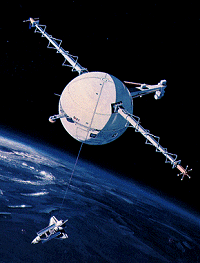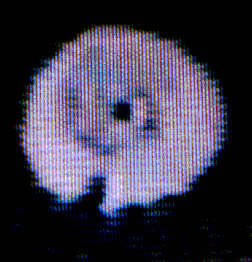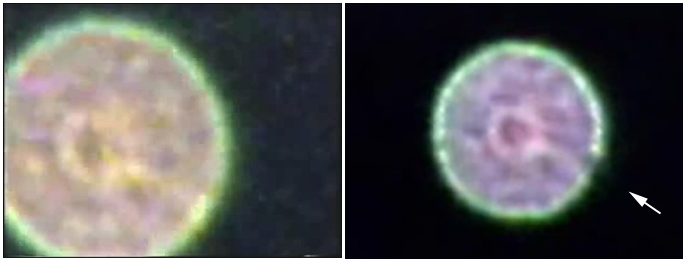
by Gary Vey for Viewzone
I can remember when I first saw them, pulsating and drifting through space. They made my hair stand on its end. I watched as dozens of them swarmed in the television pictures coming from NASA's STS75 mission in December of 1996.

The broken tether appears as a pencil shaped object surrounded by a swarm of white blobs. Are these "space debris" or possibly some form of life?
 The target of NASA's untraviolet cameras was supposed to be a 12 mile long tether used to tow a 100 million dollar satellite [Right] in an experiment that went wrong.
The target of NASA's untraviolet cameras was supposed to be a 12 mile long tether used to tow a 100 million dollar satellite [Right] in an experiment that went wrong.
The cable, made from copper, teflon and carbon fibers had snapped and separated from the space vehicle and was slowly drifting away. Examination of the cable shows that it actually melted from over 35,000 watts of electrical energy that was generated by its travel through the Earth's magnetosphere.
The experiment was to determine if tethers could be a reliable source of electrical energy, instead of batteries or generators, for the space station, satellites and other orbital missions. The results appear to show that more energy than anticipated was generated. NASA is now seeking a stronger material to carry this higher electrical load.
But it was what happened after the accident that was significant. As the tether separated and drifted behind the shuttle craft, it elongated. Mission control instructed astronaut Franklin to take a picture of it with the onboard infrared camera. As he focused and zoomed in on the broken tether the image was projected on huge screens in Houston. Engineers couldn't believe what they were seeing.

If the plate-like objects pass behind the 12 mile long tether, which is itself more than 80 nautical miles from the space vehicle, the estimated size must then be about 2-3 miles in diameter!
"What are we looking at?" the anxious voice of Houston Control inquires of astronaut Franklin Chang-Diaz. On the television screen there was a white line, the extended tether, surrounded by an ever increasing number of fuzzy, circular shapes. Some were small but others were huge. The large ones afforded a better assessment of the shape and revealed a hole in the center and a "notch," sometimes two, on the peripheral egde. This notch seems to appear in different locations on different shapes, eliminating the possibility of a video lens or camera iris artifact.
 Astronaut Franklin: "You guys getting the image?"
Astronaut Franklin: "You guys getting the image?"
Houston Control: "Franklin we see a long line, a couple of star-like things and a lot of things swimming in the foreground. Can you describe what you're seeing?"
Astronaut Franklin: "Well the long line is the tether and, uh, there's a little bit of debris that kind of flies with us and, uh, it's illuminated by the Sun at such a low angle so there's a lot of stray light and it's getting washed out quickly..."
All the time, white blobs, resembling swimming sperm, surround the tether. They seem to come from all directions, speed up and then slow down. Occasionally some large shapes slowly drift in to the frame and are eclipsed by the tether. This indicates to many observers that they are behind the tether, meaning that they must have been huge. The tether, at this point is almost 80 miles away but, knowing its size and width, the approximate size of the largest floating shapes could be measures in miles, not feet.
The shapes seem to pulsate as they move. Some have described the movement as a contraction or winding motion which alternatively unwinds and releases. The hole in the center often can be seen expanding and contracting slightly. In short, these do not seem to be vehicles or artifacts, but rather living things!

Similar shapes have been photographed closer to the ground. The images above were cpatured in the United Kingdom using an infrared camera. Note the similarity to the NASA images with the central hole and the peripheral "notch."
Critics of the "alien" assessment point out that all of the objects seem to be positioned too perfectly for the camera. If the hole suggests that the objects are flat or plate-like, why do we never see them edge on? They claim that this must prove that the shapes are, in fact, ice crystals or some other minute debris that is closer to the camera and so out of focus. Certainly this phenomenon is well known and has happened to almost everyone at some time when taking pictures, especially in the snow or in a dusty room.
But the video clearly shows these objects moving at variable speeds, sometimes stopping and changing direction. Critics have yet to explain how space debris could do this.
In the past decade we have seen life existing at the depths of our oceans, thriving in unimained pressure and temperatures. We have seen it thriving under miles of the Earth's crust and under freezing glaciers in Antarctica. It is not impossible to imagine forms of life that can exist in a vacuum, possibly thriving on radiation and other sources of energy that we know little about.

Called "sky critters" by some researchers, mysterious blobs have appeared throughout history without a satisfactory explanation. Above left: a medieval woodcut illustration. Center and Right: Images shot with night vision cameras and infrared film.
Here's a good link:NASA's Tether Video. What do YOU think?
Same shapes found on the Moon!
I watched the video on YouTube a couple of times. I agree they certainly do look like they are alive, or maybe directed by some kind of intelligence. They zoom towards the tether thing and then quickly stop or slow to a drift as if they're checking it out. I don't know though, maybe they could be some kind of machine or vehicle. Just because they pulse doesn't mean they have to be alive. A machine could do that also.
Richard G.
The official line given by NASA is that these are ice crystals. That's what they always call them so who knows. I wonder if the astronauts have made any comments about this one way or another?
Matt S.
I think the astronauts are suppose to not talk about things that happen. I also read that these things can change shape, appear and disappear pretty quickly and they are only visible when you look at them in ultraviolet or something like that.
G.C.
Why does the tether look so wide? If it's 12 miles long and looking that wide, then the object perhaps are way more tiny too, but just looking very wide.
D.B.
